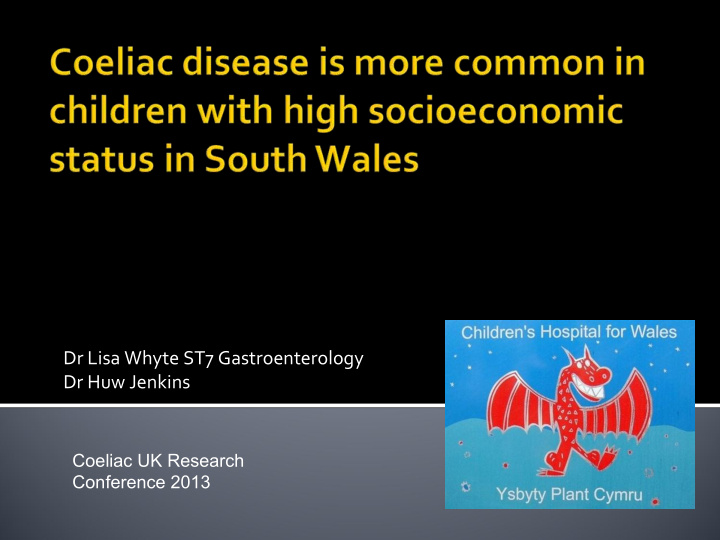



Dr Lisa Whyte ST7 Gastroenterology Dr Huw Jenkins Coeliac UK Research Conference 2013
Median age Total New cases Patients Patients Targeted number per year with GI with non GI screening symptoms symptoms % % % 1983 ‐ 89 4 11 1.8 88 12 0 1990 ‐ 98 7.5 25 3.1 75 14 11 1999 ‐ 2004 8 50 10 42 32 26 2005 ‐ 2011 14 163 27 41 23 36
Genetic factors HLA DQ2 and DQ8 Syndromes Environmental factors <2 years at diagnosis – low birth weight and neonatal infections being born in the summer months artificial feeding early weaning onto a gluten containing diet multiple infections in the first year of life maternal smoking
Low SES as a risk factor Swedish prospective epidemiological study ‐ in boys less than 2 years of age Ivarsson A, Best practise and research clinical gastroenterology 2005 Oxford record linkage study Roberts SE, Aliment Pharmacol Ther 2009 High SES as a risk factor Poor Russian Karelia and wealthy area of neighbouring Finland Kondrashova A et al. Ann Med 2008 Unpublished PhD from the Sheffield/Nottingham Lewis NR et al 2007 ▪ Incidence rate 2x > higher in higher socioeconomic groups (0.17/1000 vs 0.07/1000) No difference Scottish study White LE et al. Arch Dis Child 2012
Cross sectional study • • Paediatric CD patients • Same tertiary medical centre • Jan 1995 and Dec 2011 • Data • age at diagnosis • postcode at diagnosis • linked with quintile rank of the Welsh Index of Multiple Deprivation (WIMD) score 2008
Total paediatric population for Cardiff, the Vale of Glamorgan, Newport and Powys Adult population of Cardiff and the Vale of Glamorgan
Prevalence rates by quintile of rank of WIMD 2008 score Multivariate logistic regression analyses – confounders e.g. age and gender A separate analysis of the WIMD in <2y olds WIMD quintile vs Townsend deprivation quintile SPSS version 18
Measure of how deprived an area is within Wales (8 different types) Deprivation ranks are calculated for each area according to how deprived they are relative to each other Overall deprivation for the people living in that area (specific households may have very different levels of deprivation) Townsend deprivation score has similar limitations Using WIMD and Townsend deprivations scores to provide evidence the association
253 children 33 cases could not be linked to an LSOA (21 children) – incorrect postcode/new housing 2 postcodes were from out with the geographical area and so these were excluded
232 children (130 female and 102 male) Age range at diagnosis was 0.8 to 16 years (median 7.4 years)
Lowest Low Mid High Highest deprivation deprivation deprivation deprivation deprivation Total Num Num Num Num Num Num (Rate/1000) (Rate/1000) (Rate/1000) (Rate/1000) (Rate/1000) (Rate/1000) 66920 48651 42223 63110 77394 298298 No Coeliac 78 (1.16) 45 (0.92) 25 (0.59) 46 (0.73) 38 (0.49) 232 (0.78) Coeliac 66998 48696 42248 63156 77432 298530 Total
Prevalence rate of children with CD in Cardiff, Vale • of Glamorgan, Newport and Powys was 0.78 per 1000 Graded association between frequency of • diagnosis of CD and SES • Higher rate in children living in more affluent areas Difference between the lowest and highest • deprivation quintile is the most significant
Health seeking behaviours More likely to seek advice for minor symptoms More likely to attend for screening if risk factors Hygiene hypothesis early colonisation with a “normal” microbacterial flora encourages regulation and maturation of the immune system higher SES group the exposure to foreign antigens is much reduced
Recommend
More recommend